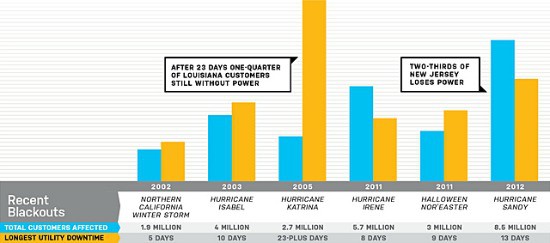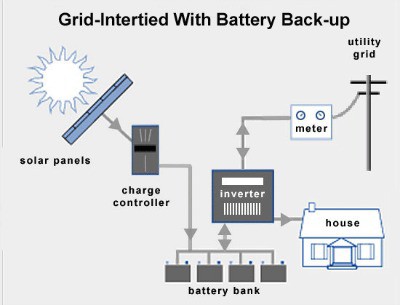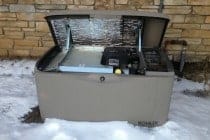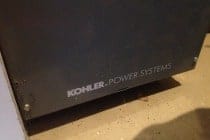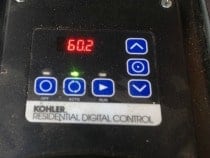After we had established the ability to heat our home in an emergency with a wood burning fireplace, my wife and I decided that back up power would be the next logical step. Unsure about the current state of solar technology, we decided to look into a stand by generator.
This is Part III of a series of posts. To read Part I (click here)
SKIP AHEAD
Why Back Up Power?
Until you have been through a SHTF event such as Hurricane Sandy or Katrina, you will have a hard time appreciating what it means to be without power. Especially while sitting in your climate controlled home, sipping on either a hot or ice cold drink while eating fresh food pulled from your refrigerator….oh ya, and reading this article on SurvivalCache.com from your tablet. The graphic below tells a haunting tale. In 2005 Hurricane Katrina, after more than three weeks, one-quarter of all Louisiana residents were still without power from the electrical grid or 2.7 million people for those playing at home. I was shocked by this statistic.
Research
When my wife and I first starting researching the topic of back up power (2009), solar made a lot of sense to us. We get a lot of sun at our home, it is renewable and the systems themselves seemed to have come a long ways. The solar companies we spoke with at the time, told me that I basically had two choices with solar. One, a completely off grid solution, where we would no longer be tied to the grid for any power and would have to completely rely on battery power. Or choice number two, a grid tied system where we would be selling unused power back to the utility but if the power went down, we would be without power as well. The downside at the time with the completely off-grid system was that the battery life wasn’t that great. We were told in 2009 that we would probably have to plan on replacing the batteries within 10 years.
My wife and I were not quite ready to make the big jump to a completely off grid system and the investment was substantial at that time, somewhere in the neighborhood of $25,000 for the system that we wanted. Keep in mind that there was a chance that we would have to replace the batteries within 10 years, which would have been $7 to $10,000 more. With this in mind, we decided against solar. They now have new “Grid Tied Back-Up” systems which weren’t available to me at the time. Based on current rebates and incentives, we might make a different decision today.
The Stand By Generator
With solar power both out of my price range and not currently available in a “Grid Tied Back-Up” system (2009), I decided to research
The portable generators might be a better fit for some, but for me they were just not an option. In my mind, my portable generator
The Brands
There seems to be several players in the stand by generator market place. The ones you will hear most about are Generac, Kohler,
Related Article: Grid Down Survival
The Size and Installation
One of the things which we had to determine was the size of our generator. There are a lot of factors that go in to determining which size generator you will need for your home. Will you require your generator to run your air conditioning? How large is your home? Do you need to power your whole home or just the basics (heat, refrigerator, lights, etc.)? Fortunately there are online questionnaires, such as this one from Kohler (Click Here), which will walk you through the basics of determining your stand by generator size. After talking with the local supplier and doing a questionnaire, we ended up going with a Kohler 20KW series generator.
The installation involved both an electrician and a plumber. I would recommend getting an electrician who is recommended by the
The installation went great. I had no issues. I can report back that after three years, I have had no issues with the Kohler 20KW Generator and that it has performed as advertised many times during power outages. The longest outage being about 15 hours. The generator also kicks on every week for 20 minutes to run a self test. You can select a time and day of the week that works best for you. I went with Saturday mornings at 9:00am, when I am most likely to be home and hear the generator kick on and run the self test.
Yearly maintenance on the Kohler generator includes an oil & filter change. If you run your generator for an extended period of time, you might need to change oil and filter more often. I can report back that changing the oil is a major pain in the ass. Removing the front cover to get to the drain plug is a little more difficult than it needs to be and is something that should be addressed by Kohler. Also, depending on the slope of the terrain you set the generator on (the most level you can find – or a poured slab), you might have to use a siphon to remove the oil. This was case for me, gravity did not work to remove all of the oil so we had to siphon the remainder out of the generator.
Sound of Freedom
Although stand by generators are not cheap, when the power goes out and you hear the generator kick on, there is no better sound in
Stay Tuned for Going Off Grid Part IV – The Wood Boiler
Photos & Graphics by:
Professional Shooter
Virginia Tom
Sunscape Solar
Popular Mechanics


